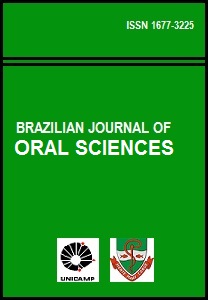Abstract
The purpose of this study was to evaluate by histological analysis, the biocompatibility of an antibiotic paste following treatment of pulpotomies in dogs. Four male adult dogs were used and their mandibular and maxilar premolars and molars (PM3; PM4 ; M1 ; PM4 ; M1 ) of both sides were submitted to pulpotomies. The antibiotic paste (CTZ) was prepared with chloramphenicol, tetracycline, zinc oxide and eugenol. After 6, 8, 9 and 10 months post-pulpotomy the dogs were sacrificed. Histological analysis of the teeth revealed an intense inflammatory process in the coronal pulp at 6 months after pulpotomy, with inflammatory cells dispersed throughout the entire apical region in this period. This process became partially reduced at 8 and 9 months after pulpotomy, and totally disappeared by the end of the experiment, at 10 months. In conclusion, the endodontic treatment with this antibiotic paste seemed to be biocompatible under the present experimental conditions. However, further clinical studies are necessary to assure that this paste is safe for use in pulpotomies in children.References
Cappiello J. Tratamentos pulpares em incisivos primários. Rev Assoc Odontol Argentina. 1964; 52: 139-45.
Topalian MK. Efecto citotóxico de los cementos selladores utilizados em endodoncia sobre el tejido periapical [cited 2004 Feb 5]. Available from: URL: http://www.carlosboveda.com/ Odontologosfolder/odontoinvitadoold/odontoinvitad 23htm.
Osorio RM, Hefti A, Vertucci FJ, Shawley AL. Cytotoxicity of endodontic materials. J Endod. 1998; 24: 91-6.
Turton JA, Havard AC, Robinson S, Holt DE, Andrews CM, Fagg R et al. An assessment of chloramphenicol and thiamphenicol in the induction of aplastic anaemia in the BALB/c mouse.
Food Chem Toxicol. 2001; 38: 925-38.
Chambers HF. Choramphenicol, tetracyclines, macrolides, clindamycin, & streptogramins. In: Katzung BG. Basic and clinical pharmacology. 9th ed. New York: Lange Medical Books, McGrawHill; 2004. p.754-63.
Chambers HF. Protein synthesis inhibitors and miscellaneous antibacterial agents. In: Bruton LL, Lazo JS, Keith LP. Goodman & Gilman’s the pharmacological basis of therapeutics. 11th ed.
New York: McGraw Hill; 2006. p. 1173-82.
Russo MC, Holland R, Nery RS. Periapical tissue reactions of deciduous teeth to some root canal filling materials. Histological study in dog. Rev Fac Odontol Araçatuba. 1976; 5: 163-77.
Giro EMA, Baussells HII, Percinoto C. Estudo histopatológico em molares decíduos de cães submetidos à pulpotomia e proteção com hidróxido de cálcio, formocresol e glutaraldeído. Rev Odont UNESP, 1991; 20: 51-62.
Souza AV, Holland R, Souza RS. Tratamento endodôntico de dentes de cães com polpas vitais em uma ou duas sessões: influência dos curativos de demora corticosteróide-antibiótico e hidróxido de cálcio. Rev Odontol UNESP. 1995; 24: 47-59.
Murata SS. Análise histomorfológica de dentes decíduos de cães após biopulpectomia e obturação dos canais com diferentes materiais [dissertation].Araçatuba: Faculdade de Odontologia de Araçatuba da Universidade Estadual Paulista; 2002.
Nery RS. Avaliação do comportamento histomorfológico de dentes decíduos de cães, após biopulpectomia e obturação dos canais radiculares com diferentes materiais [doctorate thesis].
Araçatuba: Faculdade de Odontologia de Araçatuba da Universidade Estadual Paulista; 1999.
Wright KJ, Barbosa SV, Araki K, Spangberg LS. In vitro antimicrobial and cytotoxic effects of KRI 1 paste and zinc oxide-eugenol used in primary tooth pulpectomies. Pediatr Dent.
; 16: 102-6.
Mittal M, Chandra S, Chandra S. Comparative tissue toxicity evaluation of four endodontic sealers. J Endod. 1995; 21: 622-4.
Costa CAS, Benatti Neto C, Abdalla RE, Gonzaga HFS, Lia RCC.
Estudo preliminar da compatibilidade biológica de um cimento à base de antibiótico e óxido de zinco e eugenol quando implantado em tecido subcutâneo de rato. Rev Odontol Univ São Paulo.
; 8: 65-70.
Fernandes AV. Resposta dos tecidos periapicais de dentes de cães com necrose pulpar e reação periapical crônica ao tratamento endodôntico utilizando diferentes pastas obturadoras [Tese de doutorado]. Araraquara, São Paulo: Faculdade de Odontologia de Araraquara, Universidade Estadual Paulista; 2001. 220p.
Almeida RJ. Biocompatibilidade de materiais endodônticos em Odontopediatria. Avaliação histológica da resposta inflamatória por meio de implantes intra-ósseo em cobaias guinea-pig. Projeto de Pesquisa n. D-012/2002. Mat.2991237-1. Uberlândia, Minas Gerais: Faculdade de Odontologia; 2003. 25p.
Schmalz G. Use of cell cultures for toxicity testing of dental materials-advantages and limitations. J Dent. 1994; 22: 6-11.
Hanks CT, Wataha JC, Sun Z. In vitro models of biocompatibility: a review. Dent Mat. 1996; 12: 186-193.
Schweikl H, Schwalz G. Toxicity parameters for cytotoxicity testing of dental materials in two different mammalian cell lines.
Eur J Oral Sci. 1996; 104: 292-9.
Hauman CHJ, Love RM. Biocompatibility of dental materials used in contemporary endodontic therapy: a review. Part 2.
Root-canal filling materials. Int Endod J. 2003; 36: 147-60.
Watts A, Paterson C. Detection of bacteria in histological sections of the dental pulp. Int Endod J. 1990; 23: 1-12.
22.Murray PE, Garcia-Godoy F. Comparison of the clinical and preclinical biocompatibility testing of dental materials: are the ISO usage tests meaningful? J Biomed Mater Res A. 2007; 81: 51-8.
Mcarre D, Ellender G. The biocompatibility of restorative material. J Dent Res. 1990; 69: 949.
The Brazilian Journal of Oral Sciences uses the Creative Commons license (CC), thus preserving the integrity of the articles in an open access environment.

